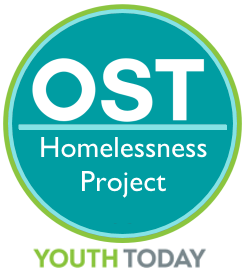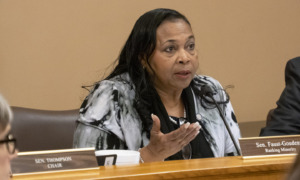
SERIES: PART 6 OF 7
 Part 1: How Do We Make Youth Homelessness Effort Bipartisan?
Part 1: How Do We Make Youth Homelessness Effort Bipartisan?
Part 2: America’s Biases Marginalize Youth, Drive Them to Homelessness
Part 3: Collective Decision-making Can Neutralize Politics of Fear
Part 4: So, How Does This Collective Decision-making Work?
Part 5: Youth Homelessness Is a Symptom, Not a Cause
Part 6: To Work On Youth Homelessness, Brainstorming, Decision Analysis Strong Tools
Part 7: Youth Themselves Must Help Design Supports To Protect Them From Homelessness
Ideas, options and alternatives
Generating alternatives is key to effective decision-making because it provides the decision-makers in a collective body with an array of choices from which to choose. The more alternatives, the better the odds of identifying the solution best suited to resolve the problem. Decision theorist Robin Hogarth describes this process as follows:
Imagination and creativity play key roles in judgement and choice. … [P]redictive judgement requires the ability to imagine possible outcomes . … Similarly, in many choice situations[,] alternatives are not given but must be created. … Indeed, it can be said that a person who exhibits neither creativity nor imagination is incapable of expressing ‘free’ judgement or choice.

Judge Steven C. Teske
The key is to generate the alternatives without critique or judgment to ensure all the possible alternatives are offered. The critique phase comes after generating all the possible solutions.
One of the essential roles of collective decision-making is the collaborative function of generating ideas, options and alternatives. It is analogous to the idiom, “Two heads are better than one,” which is short for the old proverb, “Two people working together have a better chance of solving a problem than one person working alone.”
Notwithstanding the power of brainstorming and piggy-backing ideas in a group setting, this is the place where the guardrails are established to ensure the alternatives meet a minimum criterion of effectiveness. There can be many alternatives that are effective, some more than others, but sometimes the most effective may not be as effective in certain situations, circumstances and locations for a number of reasons, including but not limited to community needs, resources and underlying causes of homelessness in that community.
Based on past applications of this approach in criminal and juvenile justice reforms, it was quite helpful to have a third party with knowledge expertise in rehabilitation programming to jumpstart the brainstorming by providing a list of proven solutions used throughout the nation.
For example, a couple of organizations, among others, that have been instrumental in this process are the Council of State Governments and the Public Safety Performance Project of the Pew Center on the States. In Georgia, for example, when generating alternatives to deciding which youth will not be eligible for commitment to state custody, an array of options was presented including (1) no commitment on a misdemeanor, (2) no commitment on a misdemeanor unless there is a prior felony, (3) no commitment on a misdemeanor unless there are two or more prior misdemeanors and a prior felony and (4) no commitment on a misdemeanor unless there are three prior adjudications, one of which must be a felony. We discussed variations of these alternatives, and after exhausting the free flow of ideas we moved to the critique stage, which brings us to the decision analysis approach.
Deciding on a course of action
It is expected there will be disagreement among diverse stakeholders working collectively to solve a problem. To minimize disagreement, it is essential to structure and quantify the process of making choices among the alternatives generated, which is called decision analysis. It uses probability theory by dissecting issues and breaking them down into component parts, which makes it easier to compare and contrast each part and decide which ones are best. Once those decisions are made, they are aggregated into a composite that will create the best macro decision, which in any statewide reform effort is the final report to the governor.

Naomi Smoot Evans
To guide the collective in their decisions, a few rules based on the law of probability must be established that also avoids subjective and emotional rhetoric that risks hijacking the process as previously discussed.
For example, in juvenile justice reform respecting the reduction of the number low-risk youth committed to the state, it was established by the Georgia Commission on Criminal Justice Reform that:
1. decisions must be related to reducing the commitment of low-risk offenders,
2. decisions must be supported by the data, and
3. decisions must be supported by empirical studies that show what works to resolve the problem.
These rules increased the probability of identifying alternatives that would reduce the number of low-risk youths committed to the state.
Similar criteria should be established when deciding the best course of action among the generated alternatives that will not only produce good outcomes, but are best suited for, let’s say, the state of New Mexico.
For example, a sample set of criteria for homeless youth reduction may include:
1. decisions must focus on the reduction of homeless youth,
2. at the most optimal cost savings possible,
3. that is data-driven, and
4. is supported by empirical studies that show what works to solve the proven.
It is also important to note that the conversation should not only be limited to programming, but should be extended to creating an infrastructure that sustains programming statewide and indefinitely. For example, we observed that the governor’s cabinet includes agencies that serve populations that have suffered oppression (Office of African American Affairs and Department of Indian Affairs) resulting from similar biases that cause suffering for homeless youth. It is to the credit of New Mexico leadership to acknowledge the historical oppression and to take action by creating agencies dedicated toward addressing the harmful effects that continue to plague these minorities.
We suggest that creating a separate agency dedicated to coordinating statewide efforts to address homelessness, including special emphasis on youth homelessness, would go a long way to developing a strong infrastructure to combat homelessness. There may be somewhere inside the executive branch of the New Mexico government an office, division or some subset of an existing cabinet agency, such as the Department of Human Services, concerned with homelessness. If so, we opine that elevating it to a separate and distinct cabinet agency will demonstrate the state’s commitment to eradicating homelessness and deliver greater influence that will effect change.
We doubt this would be a difficult sale given that the mission of creating a cabinet agency or office dedicated to homelessness is in part to save the state $139.6 million annually. And we haven’t calculated the cost of homelessness among the adult population, which will likely be at least double the costs associated with youth homelessness — say $280 million — bringing the total costs of all homelessness to about $420 million.
Before closing, we would like to return to the conversation earlier respecting generating alternatives and jumpstarting the collective conversation by presenting those alternatives that are proven to do well to address youth homelessness. The next section takes a look at proven solutions that we think would be helpful should this decision-making approach be considered.
Steven Teske is the chief judge of the Juvenile Court of Clayton County, Ga., was the national chair of the Coalition For Juvenile Justice and won the 2018 leadership prize from the Juvenile Law Center. He served two terms on the Federal Advisory Committee for Juvenile Justice, is a former member of the Board of Directors of the National Council of Juvenile and Family Court Judges and has testified before Congress numerous times on juvenile justice reform.
Naomi Smoot Evans is the executive director of the Coalition For Juvenile Justice, where she oversees the organization’s efforts to help states create brighter outcomes for youth. She co-chairs the Act 4 Juvenile Justice Coalition and was instrumental in passage of the 2018 Juvenile Justice Reform Act.





























